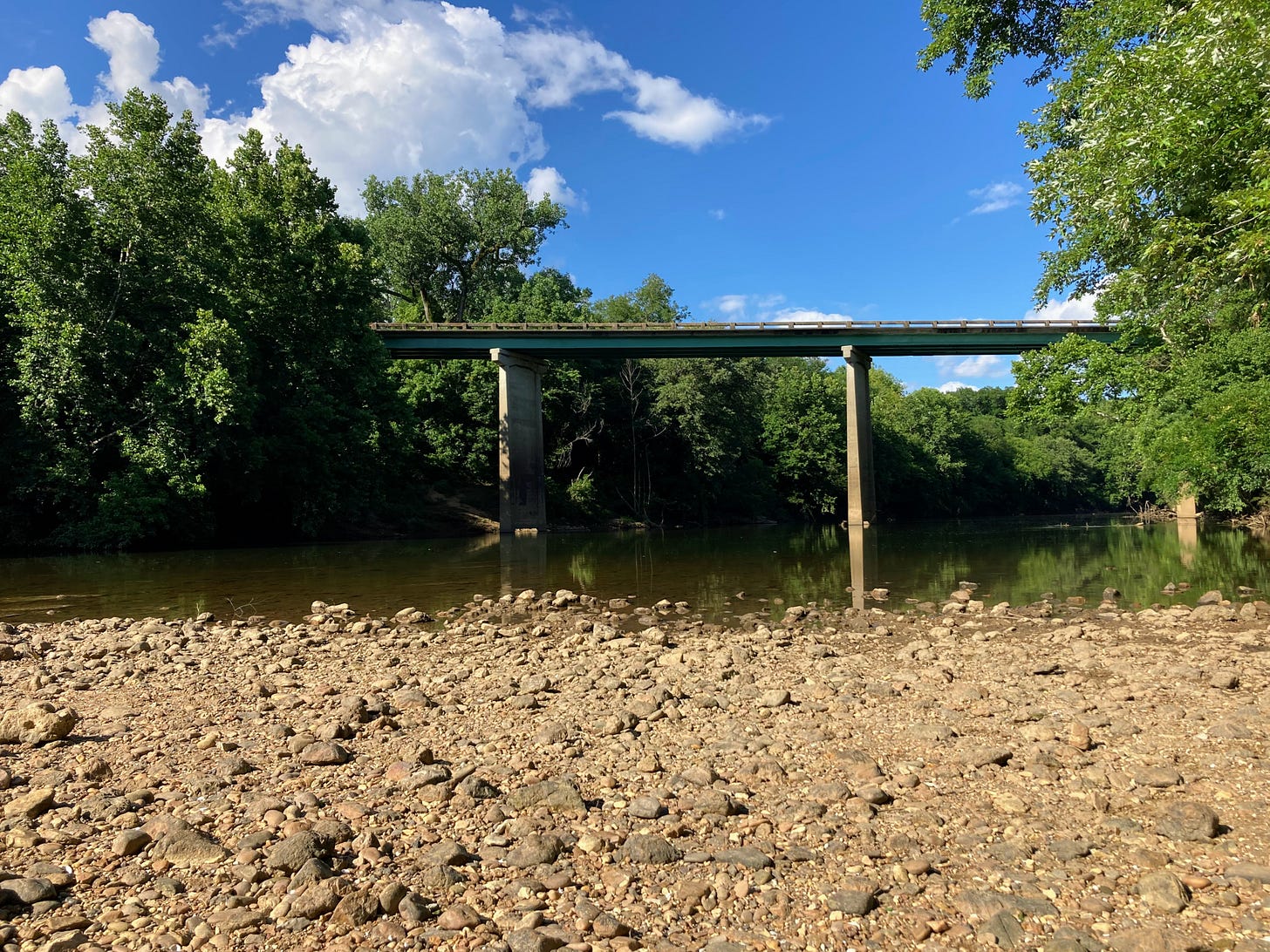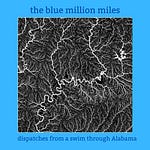Pratt’s Ferry Preserve is a put-in spot. A place to launch kayaks and canoes. Maybe more accurate (if a bit less pleasant-sounding) to call it a take-out spot, though, as I’ve seen far more boaters disembarking here at this point between two bends of the Cahaba River. A waypoint. A place for comings and goings. I’ve never done much of anything here, though. For us — my wife and I — it has been a place to idle, to float, and, yes, to watch the occasional kayaker paddle into shore.
We’d started coming here in the summer of 2020 — the pandemic at a peak, the world suspended. Pratt’s Ferry Preserve sits under a bridge in West Blocton, a small town in Bibb County about halfway between Birmingham and Tuscaloosa, where we were living at the time. It’s a quiet spot; we’ll often have the place to ourselves. A good alternative to the wildlife refuge that’s not too far away — beautiful when the lilies are in bloom but often crowded and too shallow to get a proper swim in. We had a go-to swimming hole in Tuscaloosa but, times being what they are, the e-coli was in bloom and we were forced to look further out. This spot isn’t much to speak of — a gravel beach on one side, some trees under which to read, an embankment of rock on the other side, worn to a cross-section by river time. It became my custom to swim out across the river to the spot where the channel narrows and the current accelerates. I could fashion a sort of infinity pool, turning into the current and swimming upstream. I had to swim my little heart out just to stay in the same place. Moving furiously and not getting anywhere.
Shaelyn was seven months pregnant that summer and the weightlessness afforded by the water, the relief that came with it, was one of the few things to safely seek out and enjoy beyond our apartment door. How often have I looked from the riverbank out on Shaelyn wading in the water, her belly half-submerged, the current encircling her, framed by a simple beam bridge above, and wondering what to expect?
Expecting — that’s what they say about pregnancy. You’re expecting. A funny phrase, given the circumstances. Beyond the very immediate meaning of it — a child to be born — it was getting harder and harder to hazard any guesses about what would happen next. Or what wouldn’t happen next. On the day we’d planned to be married, the Times ran the names of the first one hundred thousand Americans to die from the coronavirus. We’d canceled the wedding, of course, and I’d been furloughed. Shaelyn’s job transfer hadn’t gone through. There was no foreseeable future. I’d look downriver but couldn’t see beyond the nearest bend.
It’s been two years since we first started coming to this spot on the Cahaba. Early this July, we went back. We took the backroads across central Alabama pastureland. The wet-towel humidity of a deep south summer day. The corridors of scorched pink mimosa and deep magenta crepe myrtle blooms flanking the county roads. The play of light and shadow across the tall clouds.
You can’t step in the same river twice, we know that from Heraclitus. The river’s moved on, of course, and besides, you’ve changed, too. But Ozzie? Ozzie had never stepped in the river before. In any river. But today, framed by that same bridge, she’d stepped into the current, too.
Earlier that day, we’d buried Ozzie’s placenta under an elm tree. That’s a sentence I’d never expected to write. But so much for expectations. Maybe the idea burying Ozzie’s placenta sounds like a strange thing to do. It did a bit to me at first. Not so much anymore though. Ozzie’s placenta — I say that intentionally. Though it grew in Shaelyn’s womb, it carries 50% of Shaelyn’s genetic makeup, 50% of mine. Which is to say: It’s Ozzie’s. I learned that from Angela Garbes’s book Like a Mother: A Feminist Journey Through the Science and Culture of Pregnancy. Shaelyn had read the book early on and then made sure I did, too. Here are some other things I learned from Garbes about the placenta: The placenta’s an organ, the organ that precedes all others. It grows to support the baby and tethers the mother and the child. Provides nutrients as she floats weightless in the womb. It exchanges oxygen and carbon dioxide. It passes antibodies to the child and fetal cells to the mother. Oversees the comings and goings. And it lives in time. It will grow as the baby grows, but then it ages, too, stops growing, deteriorates. It has its own lifespan.
So when the midwife asked if we wanted the placenta, we gave it some thought. What would become of it if we didn’t want it? The hospital considers it medical waste. “Afterbirth.” They’d pitch it unless we told them otherwise.
So we told them otherwise.
Shaelyn has an autoimmune disease. One that designated the pregnancy as “high risk.” It can result in heartblock, give way to stillbirth, or calcify the placenta. At our 38-week appointment, Ozzie measured small. Come back in two days, the midwife said, and we’ll measure again. Two days later we came back and again Ozzie measured small. She wasn’t growing. We were admitted. They induced.
September 12th, a Saturday, just before ten, Ozzie came. A few moments later the placenta followed. Our midwife swaddled Ozzie and handed her to Shaelyn. Then she showed us the placenta — deep red and bulbous — pointing to the places where it had calcified, where the Wharton’s jelly had dissolved. That’s the substance that cushions the bending of the umbilical cord and without which it becomes harder for the baby to get nutrients or oxygen. Those moments during delivery when Ozzie’s heart rate had stopped — those moments when everything had stopped — we could now attribute to that, the going of the placenta.
But she was here. Blinking, breathing, grabbing for the nipple. A little early, a little yellow, and a little underweight, but blinking, breathing, grabbing for the nipple.
They double-bagged the placenta and put it on ice. And they took Ozzie to the NICU. We spent a week quarantining in the hospital to be with her — I think I spent a cumulative thirty minutes outside that week — but almost immediately the routine of those days became ritual. Every three hours, the walk through the labyrinthine hallways of the fourth floor. The bright buzz of the clustered halogens in the drop ceiling. The scrubdown with the single-use brush and nail scraper. The unfathomable comings and goings, the miracles and tragedies happening everywhere all around in the whirr and beep and wail of the room. The drawing of blood from Ozzie’s feet, the nursing, the feeding, the recitation of Rolling Thunder Revue-era Bob Dylan songs.
After a week, Ozzie’s weight was up, her blood sugar, too, and they discharged us. The placenta, in a plastic gallon container, waited for us on the counter of the nurse’s station. We stopped at the cafeteria to break a twenty for the parking lot and on the muted television in the corner, the news that Ruth Bader Ginsburg had died.
There was no one at the gate of the parking lot. We waited for what seemed like an age, dollar bills in hand, wondering if we were trapped when suddenly the gate lifted and we took Ozzie home.
We put the placenta in the freezer. And for a while, it became part of the furniture there. Every once in a while one of us would say to the other, we should bury Ozzie’s placenta soon. Definitely before we move. And after we moved we kept saying it: we should bury Ozzie’s placenta soon. And now, today, at long last, we had. Planted it under an elm tree. And then we went swimming.
That week, Ruth Bader Ginsburg’s replacement on the Supreme Court, Amy Coney Barrett, had voted to overturn Roe v. Wade, the constitutional right that had protected Shaelyn through this high-risk pregnancy. Its overturning now precludes the possibility of our having another.
But we have Ozzie and Ozzie is healthy. Wrong to say that the placenta gave out. It lives in time. And it saw her through. Sent her into water, weight, time. It came and went.
What now might we expect? What might Ozzie expect? In the foreseeable future, she can expect to swim, to join the current. She can expect the bend in the river and the unknown beyond.
Burying the placenta — as foreign a concept as it was to me and to the American medical establishment — it’s really not that uncommon. New Zealand, Indonesia, Ukraine, they all have customs regarding the placenta. In the Hmong tradition, the soul retrieves the placenta after death to wear as a jacket on the voyage to the afterlife.
“I like the thought of that,” Shaelyn said that day as we sat in the current, forty miles and two years downriver from the hospital where Ozzie was born, thinking of her jacket under the elm tree, that jacket that’s fifty percent of her, fifty percent of me.
“That when she leaves, she’ll come back to us.”









